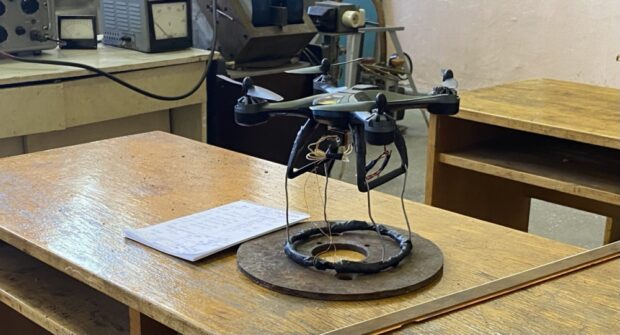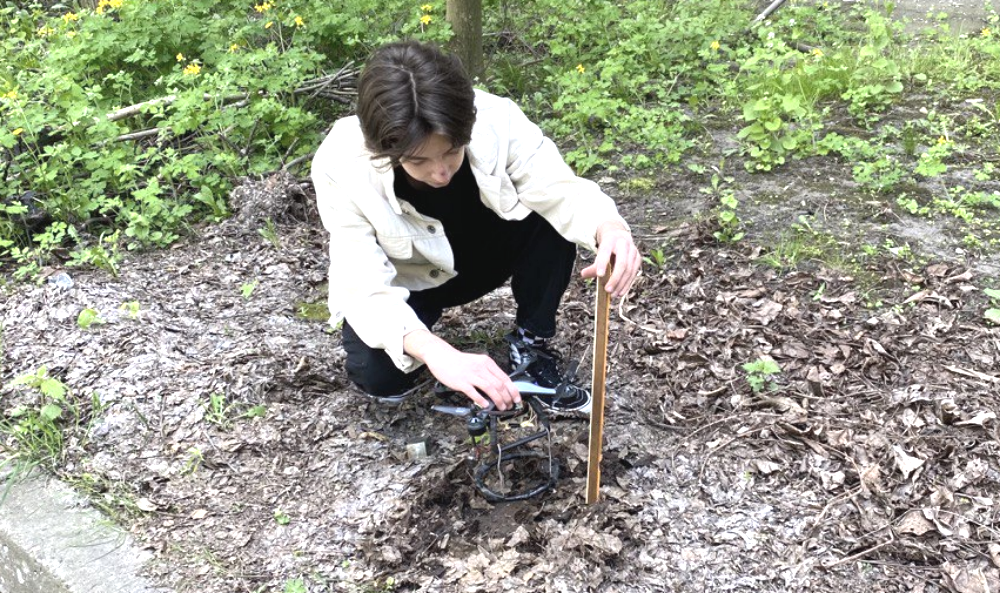In February 2022, when Russia invaded Ukraine, 17-year-old Igor Klymenko was forced to flee his home in Kyiv. He and his family moved to the countryside, sheltering in a basement as the war raged around them.
“I was living with eight people,” Klymenko says. “All this time we heard explosions, rockets, planes, and it was really hard to concentrate, to just focus, [and] not to think about the war.”
After three weeks, and with a renewed sense of urgency, the young engineer decided to revisit a past passion project: a prototype of a drone that could detect unexploded land mines and send their exact coordinates remotely to a user.
Klymenko was just nine years old when Russia invaded Crimea in 2014. At that time, feeling compelled to research ways to help his country, he came across information about the global land mine crisis. Even before the invasion, unexploded land mines were a huge threat worldwide not only to soldiers on the front lines, but also to civilians living in areas that were once war zones. In 2020, mines or other explosive remnants of war killed or injured a recorded 7,073 people, and civilians represented about 80 percent of all casualties. As many as 110 million land mines may be buried in about 60 countries.
But demining practices are slow and dangerous; for every 5,000 successfully removed land mines, one deminer is killed and two are injured. Klymenko thought he could put his computer science and engineering skills to good use to make the process safer.
Fast forward to 2022, and the teenager says, “I just started thinking that I can’t give up. I should go ahead, because this problem is becoming more relevant than in 2014. My people are defending Ukraine, my country, me, my family, and I should also help them.”
While finishing his senior year and sheltering from the attacks, Klymenko worked with scientists and programmers to hone his Quadcopter Mines Detector. He now has two working prototypes of the device and two Ukrainian patents. Just this week, at the Clinton Global Initiative in New York City, Klymenko was awarded the Chegg.org Global Student Prize, a $100,000 award for a student making an impact on society, learning and the lives of their peers.
The Global Student Prize has “provided me [the] opportunity to show the world my story, to show the world the land mining problem, and to show how it affects people,” Klymenko says, adding it’s a “good opportunity to…find people who also want to work with me on this device to create it and save lives.” He plans to use some of the prize money to further develop his drone.
“In times of crisis, we need innovation and resilience to help overcome unimaginable adversity,” Dan Rosensweig, president and CEO of Chegg says in a statement, “and Igor’s commitment to tackling the global land mine problem is truly inspirational.”
Land mines are broken down into two varieties: anti-vehicle land mines, which target tanks and armored vehicles, and anti-personnel land mines, which target people. The 1997 Anti-Personnel Mine Ban Treaty, which was signed by more than 150 countries, prohibits the use of anti-personnel mines because they indiscriminately kill both soldiers and civilians. Anti-vehicle mines usually require a certain amount of pressure on top of them to detonate. Ukraine signed the treaty in 1999, but Russia and several other countries, including the United States, did not.
So far in 2022, the Human Rights Watch has identified at least seven types of anti-personnel mines and six anti-vehicle mines in Ukraine, though only Russian forces have used anti-personnel mines. The Ukrainian government reports that about 116,000 square miles of land—or a third of the country—may be contaminated with explosives. People on the ground operating metal detectors, explosive-sniffing animals and land mine probes, which are spikes used to manually poke into the ground, are the most commonly used tools for finding these land mines, though researchers have explored using drones and other technologies in recent years.
The Demining Research Community, for example, has developed a drone that uses images and machine learning to locate mines with 92 percent accuracy. Mine Kafon, another organization, uses a team of two drones to locate land mines—the first creates a 3-D visualization of the target area and the second collects data using a metal detector, radar and a sample collection device. This data is then used to train mine-detecting software, which locates the mines on the 3-D map. On autopilot mode, this system can detect land mines with an accuracy of four centimeters, though it can also be flown manually, per the organization’s website.
Tim Bechtel, a geophysicist at Franklin and Marshall College in Pennsylvania, says that metal detectors are the most commonly-used method in Ukraine. With a group of NATO-funded scientists, Bechtel is designing a fleet of four autonomous mine-detecting robots to work on demining efforts in the country.
“The most common anti-vehicle mine is the TM 62 M,” he says. “It’s got a metal casing, so it’s very easily found with a metal detector. Anti-personnel mines are a lot smaller, but most of the Russian mines, even if they have plastic casings, still contain significant metal.”
But metal-detecting on the ground is risky, Klymenko says.
“It can be dangerous for a person, because there are really awful land mines that are just listening for vibrations in the ground”
and exploding when someone draws near, Klymenko explains. He argues that his drone is a much better, more humane way to detect mines. From a logistical point of view, the machine is also advantageous in that it can fly at all hours.
“It’s a very good idea,” Bechtel says. “Particularly in urban areas, there’s so much rubble that any other kind of vehicle that might carry a metal detector is going to have trouble getting around.”
The device uses an F5 PRO quadcopter with a metal detector Klymenko designed suspended underneath it as it flies. A built-in gyroscope detects the effect of wind on the drone. The mine detector can fly for a duration of 20 to 30 minutes and a distance of up to five miles, though these parameters could change with more expensive equipment.
Before the drone begins its flight path, it records GPS coordinates in a static location. The user then sets the length and width of the area the drone will scan. After takeoff, as soon as the metal detector encounters a mine, it sends an infrared signal to a phototransistor on an Arduino board—a type of programmable circuit board—held by the user. The board executes a code that Klymenko wrote in the programming language C++, which records how much time had passed since the beginning of the scan to when the signal was received. Using the speed of the drone, the time it launched and the time the metal detector located a mine, the code calculates the coordinates of the mine relative to the start of the run; this calculation is then translated into GPS coordinates within two centimeters of accuracy.
Altogether, it takes the drone about two to three weeks to scan a square kilometer of land and calculate land mine coordinates. Klymenko tested his device’s ability to locate both anti-tank and anti-personnel mines in the lab as well as outside in low grass and slow wind. He also experimented by varying input data and distances between the phototransistor and the detector. The inventor hopes the device can eventually be used by the military within active war zones and for demining civilian areas after war.
Now a computer science and mathematics student at the University of Alberta in Canada, Klymenko is also working part-time towards a degree in machine building at the Kyiv Polytechnic Institute. He’s continuing to refine his device with the goal of creating a minimum viable product by the end of this year.
In the future, Klymenko hopes to add a ground-penetrating radar to improve the Quadcopter Mines Detector’s accuracy, a spray paint system to allow it to physically mark a land mine’s location and artificial intelligence to provide exact coordinates and the type of land mine. Eventually, he also wants to incorporate a detonation function.
“I think it can not only save lives, but also I can inspire students,” Klymenko says, adding that his story can show others that no matter what challenges they face they should persevere.
“Because it can change the world,” he says.
Source: Smithsonian Magazine



